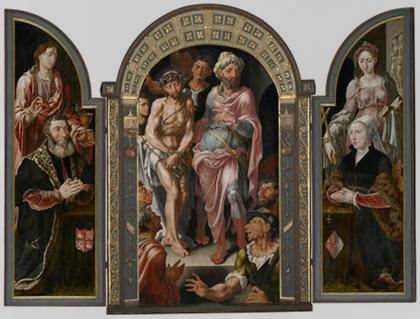![Gerhard Richter - Bougie [Kerze]](https://theartwolf.com/wp-content/uploads/2021/05/gerhard-richter-kerze-1.jpg)
Gerhard Richter
Bougie [Kerze]
1982
Oil on canvas
100 × 100 cm
Baden-Baden
© Gerhard Richter, 2012
![Gerhard Richter - Juin [Juni]](https://theartwolf.com/wp-content/uploads/2021/05/gerhard-richter-juin-1.jpg)
Gerhard Richter
Juin [Juni]
1983
Oil on canvas
251 × 251 cm
Paris, Centre Pompidou,
Musée national d’art moderne
© Gerhard Richter, 2012
‘Panorama’: Gerhard Richter at the Centre Pompidou From June 6th to September 24th 2012, the ‘Panorama’ retrospective at the Centre Pompidou brings together a selection of 150 major works by Gerhard Richter.]]>
Source: Centre Pompidou, Paris
Organised by Centre Pompidou in association with Nationalgalerie Staatliche Museen zu Berlin and Tate Modern, London; the ‘Panorama’ exhibition is organized in ten different rooms
ROOM 1. Painting photography
Gerhard Richter appeared on the European scene in the early 1960s with works inspired directly from photographs, which he called “photo-paintings”.
ROOM 2. Inheriting a tradition
Richter disagreed with Marcel Duchamp’s proclamations on the end of painting as an artistic medium, stressing its powerful link with reality. With his large canvases representing landscapes, mountains, clouds and seascapes, he has established himself as an heir to the German Romantic tradition.
ROOM 3. Opposing the motif
In the late 1960s, Gerhard Richter’s pictorial language underwent its first radical shift with his first non-figurative compositions.
ROOM 4. Releasing abstraction
Following the first experiments with non-figurative language, the works of the 1980s present more lyrical compositions: the gesture surges with energy, splattered paint, brushstrokes and flat sweeps of colour challenge one another, creating breathtaking contrasts on canvases of frequently monumental format.
ROOM 5. Revealing chance
In the 1990s, Gerhard Richter continued to paint abstract canvases using a large wooden plank and a metal squeegee which spreads the still-wet paint and gives it a fluid aspect with multiple hues.
ROOM 6. Seeing through: grey and glass
Closely paralleling his personal worries, Richter began to paint dark works in a period of uncertainty and unhappiness. These were born during a destructive instant in which the artist, dissatisfied with the result of a figurative painting, decided to erase it by covering it with a layer of grey paint.
ROOM 7. Rethinking classicism
Among the paintings of the classical genre revisited by Richter, landscapes find an increasingly important place in his work. Always painted from photographs taken during his travels or of his surrounding environment, these canvases give pride of place to nature and the sky, without any human presence.
ROOM 8. Revealing intimacy
Richter painted his first portraits in the mid 1960s. The most recent, Ella (his second daughter) dates from 2007. This portrait gallery is composed solely of representations of people close to the artist, and, exceptionally, a self-portrait.
ROOM 9. 18 October 1977
Richter took up historical painting once again in 1988. The series, entitled “18 October 1977”, evokes the date of the death of the leaders of the revolutionary Baader-Meinhof group on 18 October 1977 in Stammheim prison.
ROOM 10. Continuing to paint
“A lot of people find other mediums more attractive-put a screen in a museum and nobody wants to look at the painting anymore. But painting is my profession, because it has always been the thing that interested me most. And now I’m of a certain age, I come from different tradition and, in any case, I can’t do anything else“.
The catalogue Gerhard Richter. Panorama is published by the Éditions du Centre Pompidou and edited by Camille Morineau, curator of the exhibition and at the Musée national d’art moderne.
Related content
Gerhard Richter – Wald (Forest) – series of paintings – 50 great landscape paintings
Follow us on:


